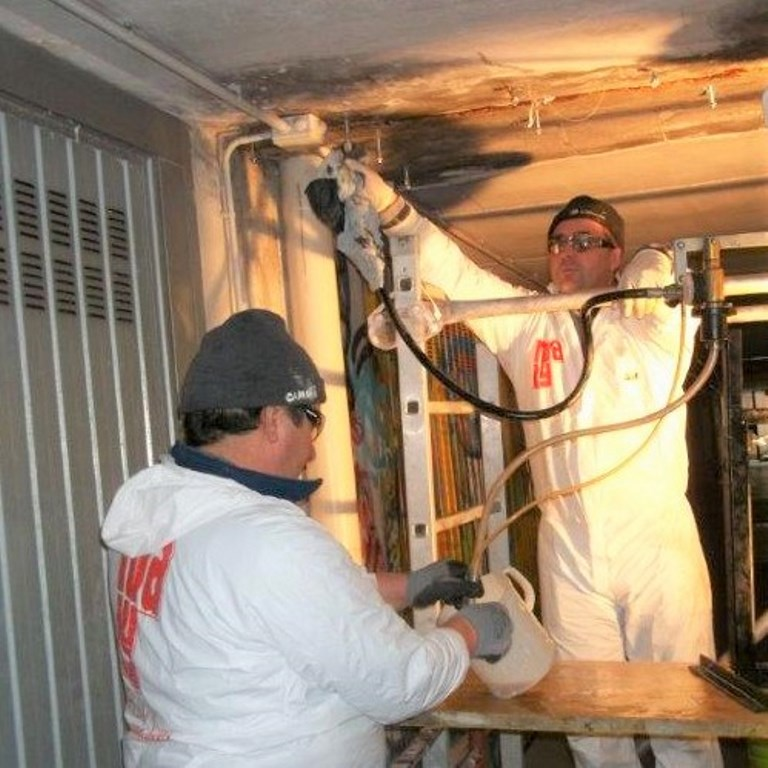



In contact with water, SYNTECH H.A.G. FLEX forms a flexible polyurethane foam. The product increases its initial volume by about 10 times in contact with fresh water. If used in environments with the presence of sea water, the expansion will take place in any case but slightly reduced in volume. Technically, it is a mono-component product which reacts spontaneously with the water present in the masonry to be sealed. The speed of reaction with just water, however, would be very slow relative to the construction site requirements. It is therefore essential to use an expansion accelerator, sold in combination with the same resin (component B). The polyurethane foam resulting from injection operations, will keep its volume stable once expanded. A good resistance to hydraulic pressure in the water flow after about 1-2 minutes from the time the reaction took place. The formation of CO₂, typical of the polyurethane reaction, will further pressurise the system, thus favouring the penetration of the resin in the cracks and cavities. In a free environment, SYNTECH H.A.G. FLEX expands to about 10 times its initial volume.
Stop the infiltration of water in underground spaces. Perfect for waterproofing filling small cavities, cracks, fissures, static and dynamic joints in concrete and in solid masonry in general.
The application surfaces should be clean, free of incrustations, crumbling and non-adhering parts, dust, moss, moulds, etc. Prepare the appropriate injectors, usually "staggered" (from one side to the other of the discontinuity to be sealed). Preliminarily inject abundant water in the discontinuity until saturation (if not already present).
Pour 100 g of component B for each kilogram of component A (ideal and recommended dosage), in a bucket. Mix the two components thoroughly with a hand tool (do not use a mixer drill). Keep in mind that the resin could react even with the environmental humidity, therefore, to reduce the waste of material it is advisable to prepare a quantity of mixture strictly necessary for the intended use from time to time (2-3 kg of mixture at a time may be more that sufficient). The mixture of SYNTECH H.A.G. FLEX and its catalyst can be injected with a manual or electric pump for monocomponent resins, at pressures ranging between 40 and 200 bar. The reaction speed can easily be adjusted based on the accelerator (component B) quantity. Adding a greater quantity of catalyst, compared to the recommended 10%, reduces the reaction time. Always clean the pump used thoroughly at the end of the operations with Nitro thinner and the specific lubricant detergent SYNTECH H.A.G. CLEANER.









Viscosity
20° C
The consumption of the product depends on the size of the vacuum volume to be filled and on the expansive reaction that occurs after mixing the two components in relation to the amount of water present.
SYNTECH H.A.G. FLEX is packaged under dry nitrogen and is very sensitive to humidity, also environmental. It is recommended that you use a very small quantity at a time and carefully close the whitewash before putting them to rest. Ensure the secure sealing of the injectors placed in the supports. Given the high injection pressures reached by the pumps, in the case of injectors not positioned securely and correctly there is a real risk that they might come out at high speed from their seat (with the risk of injury to the operators!). Carefully study the positioning of the injectors near the masonry discontinuities to be injected. Bad positioning, too close to the crack to be filled, can cause the breaking of the support itself under the pressure of the pump. Take all due care during the use of the electric pumps, which can easily reach a pressure of 200 bar, and thus cause undesired breaking of concrete and masonry supports being injected. Remove resin residues overflowing from masonry within a few hours of stopping infiltrations. Delayed removal may be more difficult.
The general information, along with any instructions and recommendations for use of this product, including in this data sheet and eventually provided verbally or in writing, correspond to the present state of our scientific and practical knowledge.